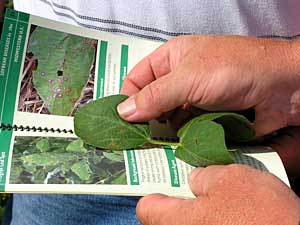|
Photos
|
July 13, 2005
 |
| Crop consultant Jim Nesseth checks a field guide on soybean diseases. He's out every day, tracking crop development. (MPR Photo/Mark Steil) |
Lakefield, Minn. — Just a mile from I-90 in southern Minnesota two hunched-over figures poke and prod a soybean field. Crop consultant Jim Nesseth and a helper are scouring the plants for signs of ill health.
"Finding anything Mitch?" says Nesseth.
Today's main target are aphids. The tiny insect sucks the juice out of soybean plants. His helper plucks some leaves and Nesseth examines them closely.
"Yuh, there's an aphid," says Nesseth, "so, they're definitely here."
But only in small numbers. Nesseth says he'll watch this field closely over the coming days. If there's a rapid increase in aphids it may be necessary to spray the crop with an insecticide to kill the pests. It's a major decision. It will cost about $1000 for this 80-acre field. But if nothing is done, aphid damage can add up quickly. Untreated, the soybean loss for this field could easily top $5000.
"We don't want to pull the trigger if we don't have to but if we need to by golly we're going to do it," says Nesseth. "Because we've seen anywhere from zero to 20 bushels an acre benefit to a treatment, to an insecticide treatment."
As he moves through the field Nesseth keeps his eyes open for any sort of disease or insect that's active.
"Yeah, there's a potato leaf hopper," says Nesseth.
An interesting find, but not a threat to soybeans.
"Now this is a classic septorial brown spot," says Nesseth.
It causes leaf damage, but again not a major threat. In fact, most of what he sees is benign. A farmer though often sees things differently. That's where crop consultants earn a big part of their fee, which average about five dollars an acre per year. Seeing blotchy brown spots on soybean leaves may convince some farmers to call in the chemical sprayer. That can cost more than ten dollars an acre. Nesseth says often his advice is to wait. He remembers a recent case.
"I went out there and I said, 'Don, it's brown spot, it's not going to affect yield. Don't worry about it, it's going to grow out of it as soon as it dries up.' 'Whoa,' he says, 'that's good news. I was scared I had some disease out here, I was going to get half a yield and that kind of stuff,'" says Nesseth.
It's not a perfect science. Nesseth says his goal is to be right 75 percent of the time. A farmer must calculate potential loss against the consultant's fee. Some have the time and expertise to do their own monitoring. This field belongs to Chuck Vancura. In addition to corn and beans, he and his sons raise thousands of hogs each year. He says there are too few hours in his day for crop watching.
"We don't get time to get over all the acres at the critical times to check them to see for the aphids or whatever we got," says Vancura. "I think it pays us in the long run to have somebody on top of it for us."
There are consultants for every type of farm operation. Some specialize in crops, others livestock. Some are experts at navigating government regulatory paperwork. Some are organic farm specialists. Fairmont banker Ove Oren sees value in hiring consultants.
"I think that in general we encourage farmers to look at consultants and get advice out of areas that they're not familiar with," Oren says.
"This is yellow nuts edge, right?," says Nesseth.
As crop consultant Jim Nesseth examines a a weed he's picked, he talks about the past. He says a cutback in state services for farmers has boosted the crop consultant business. As he studies the horizon he says he himself is a former Minnesota extension agent. He says he used to do for free, some of what he charges farmers for today. Then he drops his head and moves off slowly through the soybean field, looking for the next pest.





